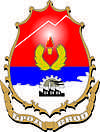Brod, Bosnia and Herzegovina
| Brod Брод Брод | ||
|---|---|---|
|
Brod | ||
| ||
 Location of Brod within Republika Srpska | ||
| Country |
| |
| Entity |
| |
| Government | ||
| • Mayor | Ilija Jovičić (SNSD) | |
| Area | ||
| • Total | 229,3 km2 (885 sq mi) | |
| Population (2013 census) | ||
| • Total | 17.943 | |
| • Density | 78,3/km2 (2,030/sq mi) | |
| Time zone | CET (UTC+1) | |
| • Summer (DST) | CEST (UTC+2) | |
| Area code(s) | 53 | |
| Website | http://www.opstina-brod.net | |
Brod (Serbian Cyrillic: Брод;[1] Croatian: Bosanski Brod) is a town and municipality located on the south bank of the river Sava in the northern part of Bosnia and Herzegovina. It is situated in the northwestern part of the Republika Srpska entity and the western part of the Posavina[2] region.
Name
Prior to the Bosnian War of the 1990s, it was Bosanski Brod. After the war the official name is only Brod.
In May 2009, the National Assembly of the Republika Srpska removed the prefix Bosanski resulting in the name Brod. Today its official name is just Brod, without the prefix Bosanski or Srpski. The Croatian town of Slavonski Brod is situated on the opposite (northern) bank of the Sava forming a built-up area of more than 110,000 inhabitants.
The bridge over the Sava River at Brod was one of the few between Croatia and Bosnia not to be destroyed; it was reinforced by NATO, using troops of the U.S. 10th Mountain Division, to keep open a link between the two countries.
Settlements
• Brod • Brusnica Mala • Brusnica Velika • Donja Barica • Donja Močila • Donja Vrela • Donje Kolibe • Donji Klakar • Gornja Barica • Gornja Močila • Gornja Vrela • Gornje Kolibe • Gornji Klakar • Grk • Koraće • Kričanovo • Kruščik • Liješće • Novo Selo • Sijekovac • Unka • Vinska i Zborište.
Demographics
1971
30,115 total
- Croats - 14,489 (48.11%)
- Serbs - 11,273 (37.43%)
- Bosniaks - 3,706 (12.30%)
- Yugoslavs - 436 (1.44%)
- others - 211 (0.72%)
1991
In 1991, the population of Bosanski Brod municipality was 34,148, including:
- Croats (41%)
- Serbs (33.8%)
- Bosniaks (12.2%)
- Yugoslavs (10.6%)
- others (2.4%)
The urban part of the municipality had in 1991 a population of 14,045, including:
- Serbs (31.39%)
- Croats (29.17%)
- Yugoslavs (19.3%)
- Bosniaks (16.26%)
Urban settlements population:
| Settlement: | Bosniak | Serbs | Croats | Yugoslavs | Others | Sum | M% | S% | C% | Y% | O% |
|---|---|---|---|---|---|---|---|---|---|---|---|
| Brodsko Polje | 196 | 2438 | 596 | 466 | 110 | 3806 | 5% | 64% | 16% | 12% | 3% |
| Centar | 528 | 477 | 843 | 684 | 93 | 2625 | 20% | 18% | 32% | 26% | 4% |
| Mahala Skele | 712 | 345 | 427 | 474 | 88 | 2046 | 35% | 17% | 21% | 23% | 4% |
| Rit | 707 | 860 | 1502 | 736 | 194 | 3999 | 18% | 22% | 38% | 18% | 5% |
| Tulek | 141 | 289 | 729 | 351 | 59 | 1569 | 9% | 18% | 46% | 22% | 4% |
Serbs were majority in Brodsko Polje, Croats in Centar, Rit and Tulek, and Muslims by nationality in Mahala Skele.
Administrative areas, 1991
The Municipality of Brod according to population census from 1991, had twenty-three inhabited settlements, divided in twelve local communities:
City local communities
- MZ Brodsko Polje 1
- MZ Brodsko Polje 2
- MZ Brod - downtown
- MZ Karađorđevo
- MZ Rit
- MZ Tulek
Rural communities
- MZ Gornji Klakar
- MZ Donji Klakar
- MZ Gornje Kolibe
- MZ Donje Kolibe
- MZ Koraće
- MZ Liješće
- MZ Novo Selo
- MZ Sijekovac
- MZ Vinska
- MZ Unka
- MZ Gornja Vrela
- MZ Grk
- MZ Barica
Notable residents
- Duško Trifunović, children's writer and poet
- Sead Mašić, football player
- Edin Mujčin, football player
- Ljupko Petrović, football coach
- Zdravko Zovko, handball coach
- Ljiljana Molnar-Talajić, opera diva
- Žarko Vidović, WWII partisan hero
See also
Notes
References
- Mangold, Max (2005), Das Aussprachewörterbuch, Duden, ISBN 9783411040667

